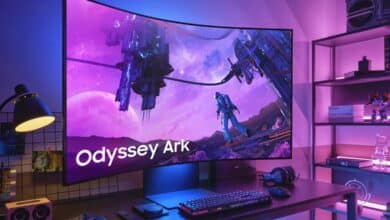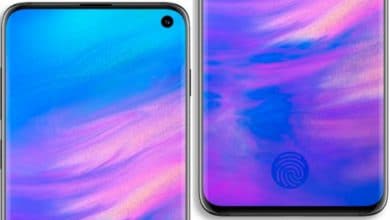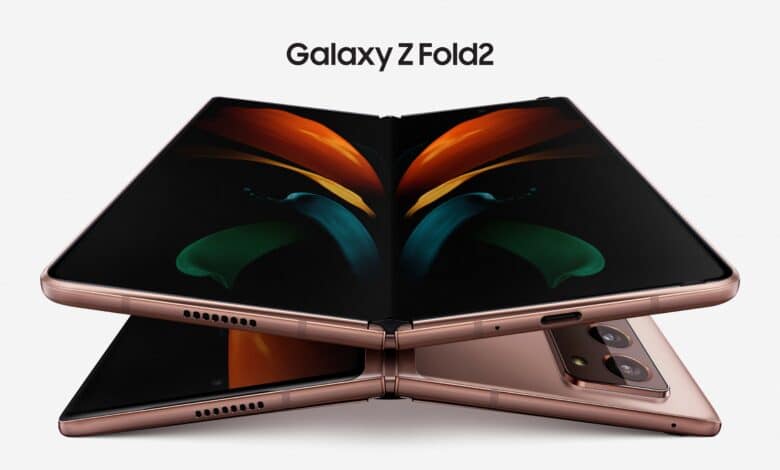
Samsung has been a pioneer for foldable phones for almost two years now. It all started with the first Galaxy Fold, which Samsung released in 2019 and was already revolutionary back then. Only there were still a few points that needed improvement. First to mention is the top, glued-on layer of the foldable screen. Some users and also reviewers mistook this for a normal screen protector and removed it, rendering the display unusable. In addition, the display on the outside, which is used in folded mode, still looked a bit immature and had very thick display edges, which made using this screen rather unattractive.
As a second attempt in the category of smartphones that fold out to a tablet, Samsung sends the Galaxy Z Fold2 5G into the race, which is supposed to remedy the teething troubles of the first fold. Whether the Galaxy Z Fold2 is finally the long-awaited mature “foldable phone” that many wish for, or whether it turns out to be a flop again, I will clarify in this review.
Workmanship and design
The Galaxy Z Fold2’s workmanship is top-notch, there’s no other way to put it. The glass-aluminum chassis feels nice in the hand and has a pleasantly valuable weight. The folding mechanism also looks robust. Inside, it contains fine brushes on both sides that keep dust and other particles out of the sensitive mechanism. The heart of the whole thing is the foldable display inside. Unfortunately, this isn’t actually made of glass like most non-foldable smartphone displays, but it still feels nice to use. Technology today, unfortunately, isn’t advanced enough to produce a glass that folds in this way.
Speaking of folding, the large touchscreen has a small groove in the center where the display folds. When you run your finger over there, you can clearly feel it and it is also visible when you look at the screen from the side. However, it is not really annoying during normal use. Besides that, “cutting-edge technology” often comes with a few small compromises, which I am personally willing to accept.
The two halves of the back, which come in “Mystic Bronze” and “Mystic Black” as standard, house the main camera module on one half, and the cover display for use when folded on the other.
In terms of design, the Galaxy Z Fold2 looks much more modern compared to its predecessor, as this time it is also based on the design of the other Galaxy models of this generation. Thus, the camera module is almost an exact copy of the camera module of the Galaxy Note 20 Ultra.


Hardware and Specsheet
Hardware

Besides the very modern concept of the foldable smartphone, the inner values of the Galaxy Z Fold2 are also powerful. In general, it can be said that the specs are decidedly similar to those of the Samsung Galaxy Note 20 Ultra. For example, the SoC of the Fold2 is the same as that of the Note 20 in the US. The memory combinations are also the same as the two larger ones of the Note 20 Ultra. Likewise, both are AMOLED screens with a refresh rate of 120 Hz. The only difference is that the inner display of the Fold2, as the name suggests, is foldable.
With 12GB of RAM and 256GB of UFS 3.1 internal storage as standard, Samsung hasn’t done things by halves, and you won’t feel compelled as a regular user to take the more expensive features if you plan on calling the Fold2 your daily driver for 2 years+.
Specsheet
Housing
| Size | Unfolded: 159.2 x 128.2 x 6.9 mm Folded: 159.2 x 68 x 16.8 mm |
| Weight | 282 g |
| Material | Glass front (folded), plastic front (unfolded), glass back, aluminum frame |
Screen
| type | Foldable Dynamic AMOLED 2X, 120Hz, HDR10+ |
| Size | 7.6 inches, 180.8 cm2 (~88.6% screen-to-body ratio) |
| Resolution | 1768 x 2208 pixels (~373 ppi density) |
| Other | Cover Display: Super AMOLED, 6.23″, 816 x 2260 pixels (25:9), Corning Gorilla Glass Victus |
Platform
| Operating system | Android 10, update to Android 11, One UI 3.1 |
| chipset | Qualcomm SM8250 Snapdragon 865+ (7 nm+) |
| GPU | Adreno 650 |
Memory
| Expandable | No |
| Internal | 256GB 12GB RAM, 512GB 12GB RAM |
| Technology | UFS 3.1 |
Main camera
| Sensors | 12 MP, f/1.8, 26 mm (wide), 1/1.76″, 1.8 µm, Dual Pixel PDAF, OIS 12 MP, f/2.4, 52 mm (telephoto), 1/3.6″, 1.0µm, PDAF, OIS, 2x optical zoom 12 MP, f/2.2, 123˚, 12 mm (ultra-wide), 1.12µm |
| Features | LED flash, HDR, panorama |
| Video | 4K@60 fps, 1080p@60/240 fps (gyro-EIS), 720p@960 fps (gyro-EIS), HDR10+ |
Selfie camera
| Sensors | 10 MP, f/2.2, 26mm (wide), 1/3″, 1.22µm Cover camera: 10 MP, f/2.2, 26mm (wide), 1/3″, 1.22µm |
| Features | HDR |
| Video | 4K@30fps, 1080p@30fps, gyro-EIS |
Audio
| Speakers | stereo speaker |
| 3.5mm jack | No |
Connectivity
| Mobile | GSM / CDMA / HSPA / EVDO / LTE / 5G |
| WLAN | Wi-Fi 802.11 a/b/g/n/ac/6, dual-band, Wi-Fi Direct, hotspot |
| Bluetooth | 5.0, A2DP, Low-Energy, aptX HD |
| NFC | Yes |
Battery
| Type | Lithium polymer 4500 mAh, non-removable |
| Charging | Quick charging 25 W. Quick wireless charging 11 W Reverse wireless charging 4.5 W |
Software
The Galaxy Z Fold2 ships with Samsung’s new One UI 3.1, which is based on Android 10. Meanwhile, the Fold2 is also already upgradeable to Android 11.
One UI is one of the most popular Android customizations and is now present on almost every Samsung smartphone. One UI is also well adapted to the new foldable layout. The screen on the front and the foldable screen each have their own home screens, which can also be personalized individually. Thus, apps that are often used when the phone is folded can be moved to the front, and apps that are primarily used in tablet mode can be moved to the home screen of the foldable display. Separate backgrounds can also be set.
Multitasking, which can be very beneficial on a foldable phone, works extremely well with One UI. Reading an article and composing an e-mail at the same time is easily possible with the Galaxy Z Fold2 and quite impressive – after all, you are only holding a phone in your hand. Therefore, I can also imagine the Fold2 in a more professional, productivity-oriented everyday life. Similar to how the Surface Duo is advertised by Microsoft. One interesting feature I discovered during testing is that you can open the keyboard so that it opens on one side of the Fold and the app opens on the other side of the Fold. This makes it possible to set up the Fold2 like a small notebook and type on it. Unfortunately, the statics throw a bit of a wrench in the works here, as the Galaxy Fold2 is too top-heavy to stand reasonably this way.
In general, Samsung has created a really solid operating system for a foldable smartphone here. The implementation of the fold-specific features feels mature and not like an afterthought.
Performance
Despite the large high-resolution display, using the Samsung Galaxy Z Fold2 always feels nimble. Apps can be opened without any noticeable delays. Scrolling is also buttery smooth on all screens of the Fold. The Snapdragon 865+ has enough power under the hood to power the large 1768 x 2208 pixel AMOLED display. The 120 Hz refresh rate on all screens pleases me and is also an important factor that takes the Fold2 out of the “gimmick corner” for me and establishes it as a competitive smartphone to be taken seriously.
When using an app on the cover display, if the phone is flipped open, the same app is automatically launched on the flipped open display as well. This also happens so instantaneously that you hardly notice it and is quite handy when you want to take a closer look at a map on Google Maps, for example.
With 5G and Wi-Fi 6, the Samsung Galaxy Z Fold2 is also well prepared for the future in terms of connectivity.
Camera
Samsung didn’t let itself be lukewarm when it came to the camera either. Often, smartphones that have a special feature – like foldability in this case – cut corners in other areas, and the first casualty is often the camera. But that is fortunately not the case here.
Three sensors with a resolution of 12 megapixels each are installed on the back. Judging by the pure resolution, the cameras do not seem very breathtaking at first glance. After all, Samsung’s Galaxy Note 20 Ultra has a 108-megapixel sensor, which is 9 times the resolution of the Fold2. The resolution is comparable to that of an iPhone 12 Pro, where every camera also has a resolution of 12 megapixels. However, the 12 MP sensor from the main camera on the back, for example, is still comparable in size to a higher-resolution sensor like from a Galaxy Note 20 Ultra, which means that the individual pixels are large and can capture a lot of light. Thus, the Galaxy Z Fold2 can still take very nice pictures – and 12 MP is certainly enough for social media.
Besides the main sensor, the module on the back also houses an ultra-wide-angle and telephoto camera (2x zoom), which also have a resolution of 12 MP. These two are, in terms of quality, on the same level as the main sensor, which means you never have to think: “Don’t I rather use the main camera in this situation, because the photos look sharper with it?”, which I appreciate very much. In general, the main camera module is a well-rounded package that I like a lot, and Samsung’s image processing takes care of the finishing touches in the end.
In the video department, the Fold2 supports everything I’d expect from a smartphone today, but nothing special extra either. 4K at 60 fps is in, plus slow-motion at up to 960 fps and HDR 10+. In addition, the main and telephoto cameras are supported by optical image stabilization, which prevents shaky pictures and videos and rounds off the system as a whole.
A total of 2 front cameras are installed. One on the cover side and one in the folded display – both as a punch hole. These are identical in terms of hardware and are based on a 10-megapixel sensor. I would have liked to see a 12-megapixel sensor like in the other cameras, because I find everything below 12 MP a bit critical nowadays. Videos are possible with the front cameras at 4K with 30 fps and video chatting also works wonderfully with it.
On the whole, the cameras of the Samsung Galaxy Z Fold2 are not breathtaking novelties – that’s what Samsung’s S-series is more for anyway – but the Koreans have installed a solid overall package here, where there is not much to complain about.
Battery
The Fold2’s energy consumption is very well managed by the software. With the 4500 mAh battery, the Fold2 gets through the day well. Overall, I got a screen-on time of around and at 7 hours until I had to charge the phone again. The Fold2 can even keep up with the Galaxy S20 Ultra, which has a 5000 mAh battery. Thus, the large and certainly energy-hungry foldable display does not detract from the battery life – and that with “only” 4500 mAh. A considerable performance that I was very positively surprised by.

You can charge the Samsung Galaxy Z Fold2 wired with a maximum of 25 watts and wireless with a maximum of 11 watts. These are not breathtaking values by today’s standards, but I did not find it annoying either. Charging small gadgets, like headphones, wirelessly with its Fold2 is also possible.
Value for money
With an MSRP of €1999.00, the Samsung Galaxy Z Fold2 is one of the most expensive smartphones ever released. For this reason alone, it is only interesting for a very small group of people who are even willing to pay such exorbitant prices for a smartphone.
However, one should not forget that for the development of revolutionary technologies, such as a foldable smartphone, a lot of money has to be invested in research as well as licensing of patents on the part of the manufacturer. At the beginning of a product life cycle, as in the case of the foldable smartphone, the costs for a product are still very high and it is mainly interesting for early adopters. But it is to be expected that with further releases of foldable smartphones, the price will also drop steadily. That’s enough business studies for this review.
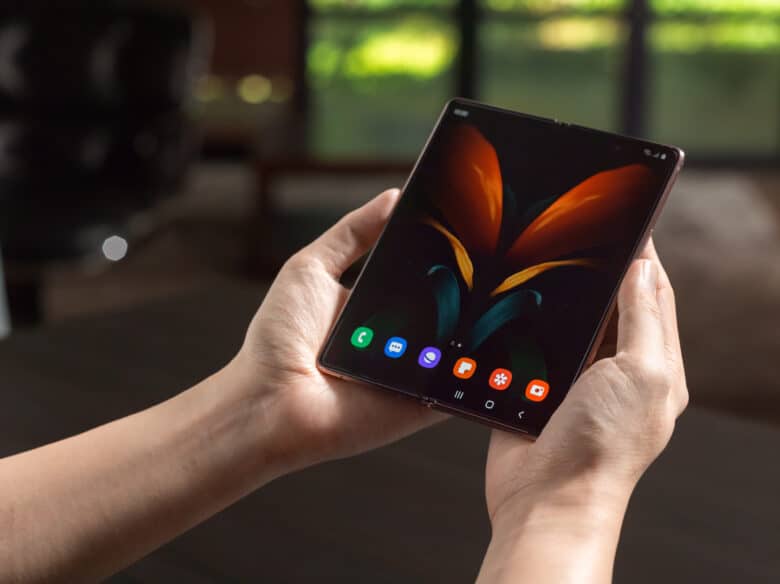
Since the release of the Samsung Galaxy Z Fold2 5G, the price has now already dropped significantly, and so a Fold2 is now also available from € 859.50 . This is a significant difference and makes the Fold2 more interesting. This makes it cheaper than a Samsung Galaxy S21 Ultra 5G at the time of writing, which I would even personally prefer it to. Of course, the S21 Ultra is more powerful and the camera is also better, but since I held the Galaxy Fold2 in my hands, I have to admit that the foldability is quite a useful innovation whose development I will follow with great interest.
In general, I have to say that the value for money is a very subjective matter here. For just under €2000, I find the MSRP to be rather overpriced, but at the current price, I think the Samsung Galaxy Z Fold2 is good value for money for a smartphone from the high-end segment.
Summary
I have to honestly admit that I fell a bit in love with the Galaxy Z Fold2 and the foldable smartphone industry in general during the review. In this, it is similar to Virtual Reality for me. They are both tech industries that I thought in advance would be short-lived phenomena that would disappear sooner or later. But after I had the chance to test them in person, my view of these two industries has turned 180°. For me, they both belong to the group of things that you have to try out for yourself in order to really appreciate them.
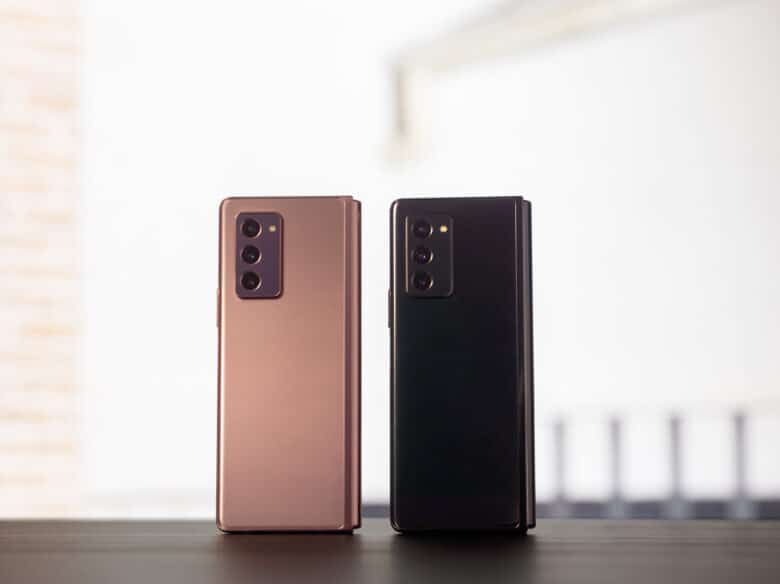
With the Galaxy Z Fold2 5G, Samsung has done a good job of bringing a mature “foldable phone” to the market. For me, there is little that I can find fault with it. Besides the foldable display, the Fold2 doesn’t offer any breathtaking other features, but it’s otherwise a very solid overall package, which I appreciate more than if they had added a few other gaudy features just for the specs sheet and cut back on other essentials.
On the whole, I can recommend the Samsung Galaxy Z Fold2 to anyone who would buy a high-end smartphone anyway, likes to take a chance on something new, and has a soft spot for new “cutting edge” technology anyway, like me.
Only one request I have for Samsung: please don’t give your smartphones such long names, otherwise we’ll end up in a name chaos soon, like it is the case with monitors 😉
Samsung Galaxy Z Fold 2 5G
Workmanship and design
Hardware
Software
Performance
Camera
Battery
Value for money
95/100
Welcome to the future! I am very positively surprised. A first-class smartphone and still a phenomenal idea to always have a tablet and a smartphone in one device.











